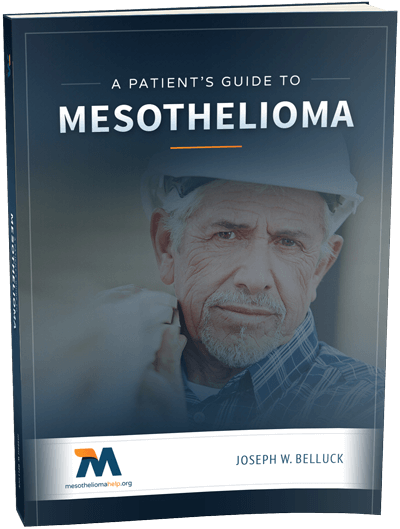Mesothelioma Help Cancer News

Projected Rise of Asbestos Disease in South Korea During 21st Century
The number of people dying of mesothelioma is near its peak in the United States. But in many Asian countries, the wave of asbestos-related deaths is just starting to build. The Ministry of Environment in South Korea projected the number of people suffering from malignant mesothelioma will continue increasing until 2045, according to the Korea Herald.
Mesothelioma is an incurable cancer of the lining of the lung, chest cavity and abdomen linked to inhaling asbestos fibers. It is a preventable disease if exposure to asbestos is avoided. Mesothelioma sufferers typically develop symptoms of the respiratory disease 20 years to 50 years after initial exposure to asbestos. Many patients are older workers, veterans or retirees.
According to the report, the number of mesothelioma patients in South Korea increased from 61 in 1996 to 152 in 2007. Meanwhile, the number of deaths from asbestos exposure more than doubled from 24 in 2001 to 57 in 2006. By comparison, approximately 2,500 to 3,000 people die each year of mesothelioma in the United States.
In Japan, researchers have observed an increase in cases of mesothelioma starting in 2000. Japan banned asbestos in 2005. The incidence of mesothelioma in Japan is expected to peak around 2030.
In Korea, a new law regulating asbestos use will take effect in 2012 and reduce the occupational hazard of asbestos. The National Institute of Environmental Research expects the regulations to prevent up to 20,000 deaths from asbestos disease a year.
Asbestos was widely used in many building materials in the United States for much of the 20th century, even though the health hazards of asbestos were well understood. The U.S. finally began restricting the use of asbestos in the late 1970s.
Find more information about mesothelioma.

Victims of Mesothelioma and Asbestos Disease Have Rights to Compensation
People who are diagnosed with health problems such as mesothelioma, an aggressive form of cancer, may be entitled to compensation from companies that manufactured asbestos. Exposure to asbestos is strongly associated with malignant mesothelioma, lung cancer and asbestosis, a chronic scarring of the lung.
A new report by the General Accounting Office, a government agency, estimates that 27 million to 100 million people in the United States have been exposed to asbestos with peak usage of the mineral fiber occurring around 1973. During the 20th century, asbestos was widely used in commercial and household applications because of its insulating and flame-retardant properties. Many workers had an occupational hazard of asbestos exposure.
The GAO report notes that as early as 1900, asbestos was recognized as a cause of occupational disease. By 1960, the link between asbestos and mesothelioma—a cancer of the lining of the lungs, chest and abdomen—was established, the government report says. Even so, manufacturers continued to sell asbestos and allow people to be harmed by asbestos products.
Mesothelioma was not recorded as a separate cause of death on death certificates until 1999 and is still not recorded as a cause of death in all states. That suggests that the number of deaths due to mesothelioma has likely been undercounted. Approximately 2,500 to 3,000 people die of mesothelioma each year in the U.S, according to federal health researchers.
Asbestos manufacturers are liable for the harm caused by exposure to asbestos products because the manufacturers knew or should have foreseen the dangers of asbestos, but failed to disclosed them. Many asbestos manufacturers have created asbestos personal injury trust funds to compensate victims of mesothelioma and asbestos disease. Since 1988, 60 trust funds have been established. According to the GAO analysis, the asbestos trusts have paid about 3.3 million claims valued at about $17.5 billion dollars. In 2010, the trusts paid 461,000 claims totaling $3 billion.
A mesothelioma victim in New York may work with an experienced mesothelioma attorney to submit to an asbestos personal injury trust a claim with supporting documents showing evidence of exposure to asbestos products and diagnosis of a specific disease. A knowledgeable New York mesothelioma lawyer will have records of many employers that used asbestos. The trust may make the mesothelioma victim an offer of compensation that is a percentage of the full value of the claim. A knowledgeable mesothelioma lawyer can offer advice on legal options including accepting the offer or filing a personal injury lawsuit seeking the full value of the harm suffered.

Gene Testing May Eventually Transform Treatment for Mesothelioma Patients
In the future, patients with mesothelioma and other forms of cancer may receive medical treatment tailored to the genetics of their tumor. After all, cancer and other diseases stem from the complex interaction of multiple genetic and environmental factors.
Mesothelioma, a cancer of the lining of the lung, is closely associated with inhaling airborne asbestos fibers. Asbestos fibers lodge deep in the lungs causing inflammation that may cause genetic damage over time.
Mesothelioma produces an aggressive type of tumor. The median survival from diagnosis is just 12 months, creating a need for new treatment options to extend mesothelioma patients’ lives. Approximately, 3,000 people a year are diagnosed with mesothelioma. Many are retired workers and veterans who were exposed to asbestos in the workplace.
Cancer centers at large university-affiliated hospitals are starting to adopt genetic testing of tumors to understand tumors at a molecular level. Gene testing seeks to identify specific genes that may mutate and promote growth of cancer cells. When a gene contains a mutation, then the protein that the gene encodes is abnormal.
If doctors can identify a specific broken or mutant gene to target in a cancer patient, doctors then may be able to silence or “knock out” the troublemaker. Some cancer-causing genetic mutations switch the proteins that signals a cell to grow and divide —proteins called tyrosine kinases—to the permanent “on” position. Blocking tyrosine kinases has proven effective for treating certain human cancers including breast cancer, gastrointestinal tumors, leukemia and non-small cell lung cancer.
In a January 2011 article in the journal Neoplasia, researchers at Harvard Medical School reported on their research focused on trying to block certain proteins in 10 lines of mesothelioma cells. The researchers reported that the greatest reduction in the viability of the mesothelioma cells occurred when they blocked multiple types of receptor Tyrosine Kinases proteins rather than singling out individual proteins.
Genetic testing is changing doctors perception of cancer. Identifying the right gene to target may mean malignant tumors are treated more like an infectious disease after doctors understand the virus or bacteria that causes the disease.

Cases of Mesothelioma Disease on the Rise, World Health Organization Warns
A recent bulletin published by the World Health Organization estimates that 92,252 people around the world died of mesothelioma in the 15-year period from 1994 through 2008. Two-thirds of those deaths have occurred since the year 2000 and the incidence of mesothelioma is on the rise, the report said. Mesothelioma is an aggressive and largely preventable form of cancer associated with breathing asbestos fibers.
A preponderance of the mesothelioma deaths analyzed by the WHO involved pleural mesothelioma, a malignant cancer of the lining of the lung and chest cavity. Pleural mesothelioma is seen far more often than peritoneal mesothelioma, a cancer of the lining of the abdomen caused by ingesting asbestos dust. Pericardial mesothelioma, a cancer of the lining of the heart, is rarer still.
Mesothelioma is slow growing and symptoms typically appear 30 years or longer after initial exposure to asbestos. Many mesothelioma sufferers are retired workers or veterans. The median survival after diagnosis is typically 9 to 12 months and the median age at death 70.
Of the 92,252 recorded mesothelioma deaths, the vast majority occurred in high income industrialized countries including the United States, the United Kingdom and countries in Western Europe, the report said. The countries with the highest cumulative mesothelioma deaths tended to be the countries that were the largest users of asbestos. They also are more diligent in recording mesothelioma deaths.
Underreporting is a common problem with rare diseases such as mesothelioma that are difficult to diagnose. The actual number of mesothelioma deaths is likely much higher, the researchers acknowledged. Some countries such as China, India, Thailand and the Russian Federation that are large users of asbestos did not provide mesothelioma death data to the World Health Organization.
The use of asbestos has been strictly limited in the United States since the late 1970s and it has been banned in many European nations. Still, many workers such as construction workers, electricians, plumbers and demolition workers face an occupational hazard of asbestos exposure in the workplace. The WHO said the burden of mesothelioma may be gradually shifting to developing countries that used asbestos more recently and those countries should prepare for an increase in the number of mesothelioma deaths in coming decades.
New York Father Raises Awareness for Peritoneal Mesothelioma As His Daughter Battles the Disease
A Mechanicville, New York father has taken his kayak to the Hudson River to help raise the public’s awareness of peritoneal mesothelioma. His 26-year-old daughter was diagnosed with the disease nine years ago and was given just twelve months to live. Since then she has endured six surgeries, and now, her father says, she is in constant pain.
Peritoneal mesothelioma is a form of cancer that is almost always caused by asbestos exposure and affects the lining of the abdomen. While there are close to 3,000 cases of all forms of mesothelioma diagnosed in the United States each year, less than 10% of those are peritoneal. The cancer, which is often associated with former industrial workers who were exposed to asbestos decades ago, is virtually unheard of among young adults.
Treatment of peritoneal mesothelioma is often similar to other cancers involving surgery, chemotherapy and radiation. However, physicians at the University of Pittsburgh Medical Center, known for treating mesothelioma patients, often use hyperthermic intraperitoneal chemoperfusion (HIPEC) as a means to battle the disease. HIPEC involves bathing the patient’s abdomen with heated high-dose chemotherapy drugs to reach the multiple tumors within the abdominal cavity. The news article in the TimesUnion.com did not indicate where the woman is being treated.
The man and his friends paddled from Schuylerville to Mechanicville. One friend was diagnosed with the same disease two years ago and wanted to offer her support to the family. The trio kayaked about 16 miles through locks 4 and 3. The man hopes to make this an annual trip with next year’s being bigger and better.
Free Mesothelioma Patient & Treatment Guide
We’d like to offer you our in-depth guide, “A Patient’s Guide to Mesothelioma,” absolutely free of charge.
It contains a wealth of information and resources to help you better understand the condition, choose (and afford) appropriate treatment, and exercise your legal right to compensation.
Download Now